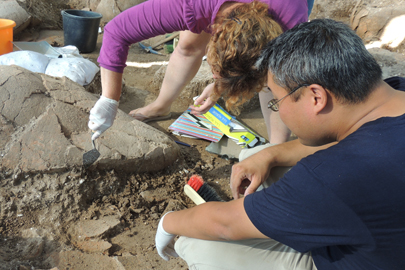Archaeologists discover largest, oldest palatial wine cellar
3,700-year-old storeroom held 2,000 liters of strong, sweet wine
 Eric H. Cline/The George Washington University
Eric H. Cline/The George Washington University Andrew Koh, with Nurith Goshen of University of Pennsylvania, takes samples from an ancient jug for organic residue analysis.
Would you drink wine flavored with mint, honey and a dash of psychotropic resins? Ancient Canaanites did more than 3,000 years ago.
Andrew Koh, associate professor of classical studies, was part of a team that unearthed the oldest — and largest — palatial wine cellar in the Near East, containing 40 jars, each of which would have held 50 liters of strong, sweet wine.
The cellar was discovered in the ruined palace of a sprawling Canaanite city in northern Israel called Tel Kabri. The site dates to about 1,700 B.C., and isn’t far from many of Israel’s modern-day wineries.
Koh partnered with members of the Brandeis chemistry department to analyze the jar fragments using organic residue analysis. Collaborating with professors Barry Snider, Christine Thomas, Casey Wade and Isaac Krauss, Koh found molecular traces of tartaric and syringic acid, both key components in wine. They also identified compounds suggesting ingredients popular in ancient wine-making, including honey, mint, cinnamon bark, juniper berries and resins. The recipe is similar to medicinal wines used in ancient Egypt for 2,000 years.
The team’s findings were presented Friday in Baltimore at the annual meeting of the American Schools of Oriental Research. Eric Cline, of The George Washington University, and Assaf Yasur-Landau, of the University of Haifa, co-directed the excavation. Koh was an associate director, and several Brandeis students participated in the excavations.
Koh analyzed the proportions of each diagnostic compound and discovered remarkable consistency between jars.
“This wasn’t moonshine that someone was brewing in their basement, eyeballing the measurements,” Koh notes. “This wine’s recipe was strictly followed in each and every jar.”
Important guests likely drank this wine, notes Yasur-Landau.
“The wine cellar was located near a hall where banquets took place, a place where the Kabri elite and possibly foreign guests consumed goat meat and wine,” he says.
Who hosted those banquets, however, is a mystery. Archaeologists have uncovered no written records or seals at the site that could indicate who lived there. The palace was abandoned around 1,500 B.C. for unknown reasons.
At the end of the season, the team discovered two doors leading out of the wine cellar — one to the south, and one to the west. Both probably lead to additional storage rooms. They’ll have to wait until 2015 to find out for sure.
Editor’s Note: The study’s findings generated significant media coverage, including:
Ancient wine cellar reveals a sophisticated drink
Associated Press, Nov. 22, 2013
Ancient wine found on jars unearthed from 3,700-year-old cellar in Israel
The Guardian, Nov. 22, 2013
Wine Cellar, Well Aged, Is Revealed in Israel
New York Times, Nov. 22, 2013
Ancient Wine Bar? Giant Jugs Of Vino Unearthed In 3,700-Year-Old Cellar
NPR The Salt, Nov. 22, 2013
Very Well Aged: Archaeologists Say Ancient Wine Cellar Found
Wall Street Journal, Nov. 22, 2013
* * * *
Categories: Research, Science and Technology





